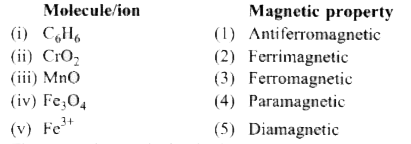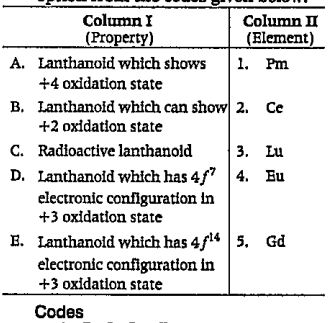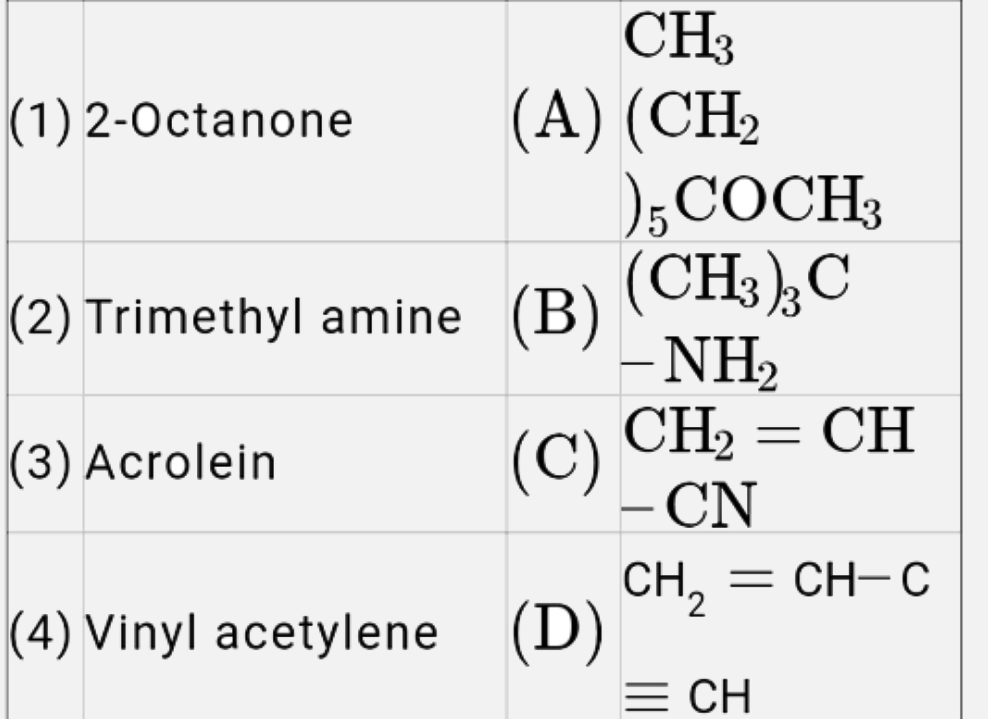The colour of the solution/precipitate obtained in the elemental analysis of an organic compound and the molecule/ion responsible for the colour are given below. Choose the incorrectly matched pair:
Prussian blue - Fe4[Fe(CN)6]3.xH2O
Black - PbS
Violet colour - [Fe(CN)5NOS]4−
Yellow - (NH4)2MoO4
The correct Answer is:D
To solve the question regarding the incorrectly matched pair of color and the corresponding molecule/ion in elemental analysis of organic compounds, we will analyze each option provided in the question step by step.
Step 1: Analyze the first pair
- Color: Prussian blue
- Molecule/Ion: Na4(Fe(CN)6) (ferric ferrocyanide)
Explanation:
When nitrogen is present in an organic compound, it can be detected by fusing the compound with sodium to form NaCN. This is then reacted with iron(III) chloride (FeCl3) to produce Prussian blue, which is indeed correctly matched.
Step 2: Analyze the second pair
- Color: Black
- Molecule/Ion: PbS (lead sulfide)
Explanation:
When sulfur is present in an organic compound, it is fused with sodium to form Na2S. When Na2S is reacted with lead acetate, it produces lead sulfide (PbS), which is a black precipitate. This is also correctly matched.
Step 3: Analyze the third pair
- Color: Violet
- Molecule/Ion: Na4(Fe(CN)5NO)
Explanation:
When sulfur is present, it can also be detected using sodium nitroprusside, which gives a violet color when reacted with the sodium sulfide solution. This pair is correctly matched.
Step 4: Analyze the fourth pair
- Color: Yellow
- Molecule/Ion: NH4(MoO4)
Explanation:
Phosphorus detection involves fusing the organic compound with sodium to form Na3PO4, which when treated with ammonium molybdate gives a yellow compound known as ammonium phosphomolybdate. However, the pair suggests NH4(MoO4), which is not the correct product for phosphorus detection. This is the incorrectly matched pair.
Conclusion:
The incorrectly matched pair is the one with the yellow color and NH4(MoO4).
Final Answer:
Option D: Yellow color with NH4(MoO4) is the incorrectly matched pair.
---
- Color: Prussian blue
- Molecule/Ion: Na4(Fe(CN)6) (ferric ferrocyanide)
When nitrogen is present in an organic compound, it can be detected by fusing the compound with sodium to form NaCN. This is then reacted with iron(III) chloride (FeCl3) to produce Prussian blue, which is indeed correctly matched.
- Color: Black
- Molecule/Ion: PbS (lead sulfide)
When sulfur is present in an organic compound, it is fused with sodium to form Na2S. When Na2S is reacted with lead acetate, it produces lead sulfide (PbS), which is a black precipitate. This is also correctly matched.
- Color: Violet
- Molecule/Ion: Na4(Fe(CN)5NO)
When sulfur is present, it can also be detected using sodium nitroprusside, which gives a violet color when reacted with the sodium sulfide solution. This pair is correctly matched.
- Color: Yellow
- Molecule/Ion: NH4(MoO4)
Phosphorus detection involves fusing the organic compound with sodium to form Na3PO4, which when treated with ammonium molybdate gives a yellow compound known as ammonium phosphomolybdate. However, the pair suggests NH4(MoO4), which is not the correct product for phosphorus detection. This is the incorrectly matched pair.
The incorrectly matched pair is the one with the yellow color and NH4(MoO4).
Option D: Yellow color with NH4(MoO4) is the incorrectly matched pair.
Topper's Solved these Questions
- ORGANIC CHEMISTRY-SOME BASIC PRINCIPLES TECHNIQUESBOOK - PRADEEPCHAPTER - ORGANIC CHEMISTRY-SOME BASIC PRINCIPLES TECHNIQUESEXERCISE - Competition Focus (Jee (Main and Advanced)/Medical Entrance) II. Multiple Choice Questions (with one or more than one correct answers)
8 Videos
- ORGANIC CHEMISTRY-SOME BASIC PRINCIPLES TECHNIQUESBOOK - PRADEEPCHAPTER - ORGANIC CHEMISTRY-SOME BASIC PRINCIPLES TECHNIQUESEXERCISE - Competition Focus (Jee (Main and Advanced)/Medical Entrance) III. Multiple Choice Questions (Comprehension)
12 Videos
- ORGANIC CHEMISTRY-SOME BASIC PRINCIPLES TECHNIQUESBOOK - PRADEEPCHAPTER - ORGANIC CHEMISTRY-SOME BASIC PRINCIPLES TECHNIQUESEXERCISE - Analytical Questions and Problems with Answers/Solutions (Problems)
4 Videos
- HYDROGEN BOOK - PRADEEPCHAPTER - HYDROGEN EXERCISE - COMPETITION FOCUS (Assertion-Reason Type Questions) Type 2
15 Videos
- P-BLOCK ELEMENTS (NITROGEN FAMILY)BOOK - PRADEEPCHAPTER - P-BLOCK ELEMENTS (NITROGEN FAMILY)EXERCISE - Competition focus jee(main and advanced)/ medical entrance special) (VIII. Assertion-Reason Type Questions)
10 Videos
Similar Questions
Knowledge Check
Molecules/ions and their magnetic properties are given below.

The correctly matched pairs in the above isAi-5, ii-3, iii-2, iv-1, V-4Bi-3, ii-5, 111-1, iv-4, V-2C1-5, 11-3, iii-1, iv-2, v-4Di-5, ii-3, iii-1, iv-4, V-2A blue colouration (in solution or precipitate) is not obtained when:
Aammonium hydroxide dissolves in copper sulphateBcobalt chloride reacts with NH4SCN in presence of amyl alcoholCferric chloride reacts with sodium ferrocyanideDaqueous ammonia reacts with white precipitate of solver (I) chlorideWhat is the colour of the precipitate obtained in Potassium Ferrocyanide test for cadmium ions ?
ABluish whiteBDirty whiteCGreenish whiteDWhite
The colour of the precipitate obtained when an aqueous solution sodium chloride is treated with silver nitrate solution is
View SolutionThe colour of the precipitate obtained when an aqueous solution of sodium chloride is treated with silver nitrate solution is
View SolutionChoose the incorrect pair from the matches given below.
View SolutionThe blood red colour obtained in the detection of nitrogen and sulphur together in an organic compound in Lassaigne's test is due to
View SolutionMatch the property given in Column I with the element given in Column II and Choose the correct option from the codes given below.

View Solution

